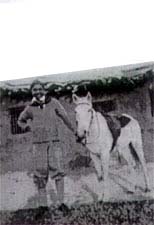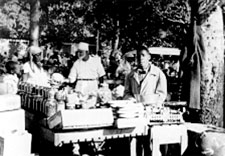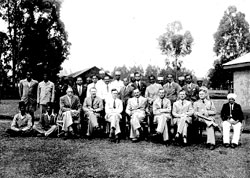
| Dedication |
|
|
| Preface |
|
|
| Contents |
|
|
| Personal
Tributes to Pascoal |
|
|
| Family Trees |
|
|
| About the Author |
|
|
| Home |
|
In 1929 Pascoal sailed from the harbour of Murmagao for the port of Mombasa on the east coast of Africa. This was his second ocean voyage; and it was longer than the previous trip to Karachi. Disembarking at Mombasa, Pascoal found himself in a bright, sunny tropical paradise that startled him because of its close resemblance to Goa. It was equally warm and humid on this rocky coast. But of course, the African people who inhabited it were so different. Following instructions Pascoal caught a train to Nairobi - capital of the Kenya colony. On the journey he observed that the train was manned by European personnel. Yet he was pleasantly surprised to discover Asians on the staff and several Goan stewards attending to the catering. As the train snaked its way through dense jungle and arid thorn bush tracts, he looked out of the window and saw that the land was teeming with wild life: fierce and ferocious lions, herds of elephants, tall stately giraffe, zebra, wildebeest, cheetah, and a host of smaller predators. There were also big ostriches strutting about, and birds of every hue. When Pascoal woke next morning, the terrain was changing and the train was climbing. He was greeted at the terminus by his brother-in-law Andre Mendonca who took him to his sister and their family at home in the railway quarters. It was a happy re-union. Nairobi, being at a high altitude, was very cold. Pascoal had to wear a number of pull-overs by day, and tuck himself under a layer of woolen blankets by night. He spent several months relaxing in the company of his sister and her family, observing life in this wondrously beautiful new continent. His ear soon got attuned to hearing the local dialect spoken freely all around him. Gradually, the young man began to pick up a smattering of Swahili words and phrases to compile a parallel vocabulary. The Goans Pascoal met a number of Goans living in Nairobi, most of them in the lower ranks of the Kenya Government Administration. They knew how to toe the line, and were meek and subservient to the British authorities. For this was very much the white man's preserve: the Africans were downtrodden, and could not aspire to enter the colonial service. However, Goans enjoyed positions of trust in the Government and had a good reputation for honesty and integrity. The few Goans who were in independent business and trade appeared to be quite prosperous. But all the same, those who were in white collar jobs in the administration enjoyed greater prestige in the eyes of their compatriots. On the whole the Goans, who had started coming into Kenya at the turn of the century when the railways were being established, had achieved good standing. A few had even created a niche for themselves as doctors and lawyers,some had entered the public arena and a street in Nairobi was named after the pioneers, Dr. Ribeiro and Julio Campos. Through their endeavours and the subsequent leadership of Dr. A.C.L. de Sousa, the community could boast its very own Goan School in Nairobi and several smaller ones in other towns. Yet Goans strangely, did not merge even into the Asian mainstream. In fact, they regarded themselves "Portuguese" because they were Portuguese subjects. They considered themselves devout Catholics and attended services in the church which they had helped to build in Nairobi to honour their patron St. Francis Xavier. They strictly adhered to the western way of life, took pride in their knowledge of English and Portuguese, and separated themselves from those Asians who were not so proficient and maintained traditional dress or customs. Yet ironically the Goans clung to the age-old Indian system of caste. This attitude went so far that, apart from strictly refraining from inter-caste marriage, the taboo extended itself to the formation of separate and exclusive social clubs. Even with this fleeting exposure, young Pascoal came to learn the ropes. Though he saw several opportunities for jobs, he decided to bide his time until an opening into Government service appeared. So it was only as late as 2nd October 1929 that he joined the provincial administration in a clerical capacity. For a short while he served in the office of the District Commissioner in Nairobi. Smart and observant, he rapidly learned whatever he could. And then quite suddenly he was sent on a posting. Frontier postings When Pascoal came to know that he was to be despatched far away to a border outpost, he was dismayed. But realising that this was the routine procedure for a new recruit and there was no option if he was to stay on in service, he manfully accepted. And so, for a long stretch of nineteen years this service carried him to almost all the provinces including the remote and arid regions of the bleak Northern Frontier District. It was an uphill task but Pascoal faced the grim challenge, determined to put his his best foot forward and climb up the ladder. His first posting took him to Wajir, deep in the northern desert. It was quite a strenuous trip. More often stores were transported on the back of camels moving in a long procession through the desert. He was provided with train accommodation to make the first lap of the journey: from Nairobi to Nanyuki Onward to Meru he travelled by lorry. Here he rested for a few days with his cousin Aloysious de Mello. Then leaving Meru early in the morning, he moved on in a convoy of trucks, much exposed to the heat and dust while perched on top of a six-wheeler truck. Nights were spent in tents pitched close to one another. More often the only water available came from dirty ponds. At Archer's Post there was a river crossing which occupied the entire hot day. The night was spent on the other bank. Early next morning, while it was still cool and pleasant the convoy moved on. The next stop was Absweny - its exotic Welsh name a nostalgic reminder for the British colonials! This proved surprisingly most welcome - a small outpost with a water-point! Stopping here to eat and be refreshed, the party resumed the last lap of the desert journey. It was late in the evening when they finally reached Wajir, their destination! On arrival Pascoal got a warm welcome from A.F.R. Dias, the Goan District Clerk, whom he would be replacing. He was made most comfortable that night and enjoyed a well-earned rest after the rigours of the road. Dias introduced the new-comer to Haji Bilal Teno Khamos who took over as Cashier, and more significantly to Luis Barreto. This Goan Customs Clerk subsequently became Pascoal's "guide, philosopher and friend". For Barreto also turned out to be a wonderful companion in that desert wilderness. Pascoal learned from him to use a shot-gun to advantage. The region abounded in guinea fowl, partridge and other game birds. Two and half years in this desolate outpost might otherwise have been boring and frustrating; but time seemed to just fly when, to his chagrin, Pascoal was transferred to Bura. He was loath to leave his new friend, but again - no option! So to Bura Pascoal went by truck. It was another remote station, to the south, on the Thana river. He was sent to relieve the District Clerk who had taken ill. The man was one M.D. Pereira - better known as "Mad Pereira". Pascoal did find him rather whimsical. The settlement was situated on the bank of the river, surrounded by tall elephant grass, and infested with vicious snakes. The hut he occupied was also made of grass, and he was constantly uneasy - aware of the presence of reptiles and other crawly creatures lurking there. It was altogether a nasty experience for even Harrison Lloyd, the "D.C."/District Commissioner - was a difficult person to work for. Fortunately however, his assistant, the A.D.C., Edward Beetham, was altogether a different cup of tea. Then a junior officer, fresh from Oxford, he was pleasant and considerate. Later he rose to be Governor of Ghana! Pascoal was glad of his next posting which, fortunately, came quite quickly. He was transferred to Moyale, a station situated still further north on the border between Kenya and Abyssinia. They lived in barricaded enclosures for fear of wild animals. There were just two European officers. The place was truly remote and undeveloped. The tribes seemed wild. Yet here Pascoal encountered a well-known and popular Goan personality - Julio da Costa. Unlike most Goans, this Goan District Clerk had integrated with the environment. He married a local Boran girl by whom he had a son, and so fluently could he speak the local dialect that he was considered a member of the tribe. Pascoal was learning all he could, all the time. He worked under da Costa and imbibed his work ethic. The District Comissioner was Gerald Reece who later went to British Somaliland as Governor, and was subsequently knighted. It was from Reece that young Pascoal learnt horse-riding and tennis. Though a firm disciplinarian, Reece was warm-hearted and generous. When he was leaving Moyale he presented his pony to Pascoal.
Pascoal's next posting transferred him to Isiolo, the headquarters of the district. Here he remained until his first home leave in 1933. He had come a long way. For four years he had served as Cashier and District Clerk in the Northern Province. But this was still only just the start of his career.
| ||||||
| Administration staff in Isiolo | ||||||
|


